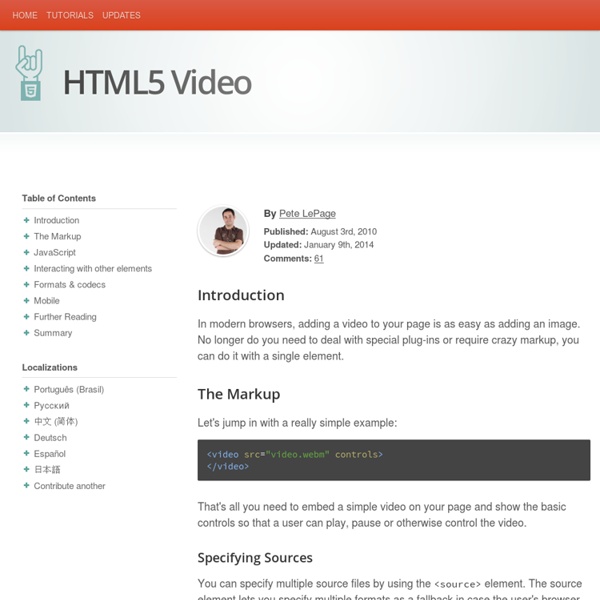HTML5 Studio
⧉ Info Slider Carousel Image gallery in a carousel UI. Page through the images quickly, and click to view full size. CSS 2D Transforms CSS 3D Transforms input type=range Your browser may not fully support these features. View SourceDownload Sample WebGL Globe A WebGL sphere of news stories. WebGL CSS3 2D transforms CSS3 transitions Webm video ASCII Art Synchronized ASCII art video via WebSockets. HTML5 WebSockets Orientation Physics Break up a video into lots of boxes and move them around by titling your machine. Canvas Device Orientation Video SVG Puzzle Solve the puzzle! SVG SVG Transforms Notification Time! Schedule a countdown to a notification, like an alarm clock. Desktop Notifications Date.js Video PiP Use Picture-in-picture to swap between two video sources while enjoying a color glow effect. HTML5 video Media element API Canvas Geolocation Peruse local job listings and envision your commute. Geolocation Google Base API Google Maps API Video Cube HTML5 video Canvas CSS 2D Transforms CSS3 mask image
Getting a WebGL Implementation - WebGL Public Wiki
The WebGL 1.0 specification has recently been released, and the latest builds of several browsers are close to reaching full conformance. Here are instructions on how to obtain a copy of a browser supporting the WebGL specification. As various implementations reach 100% conformance, expect that browsers will have this functionality built in to their latest releases, and not require any manual steps to enable it. Firefox WebGL is supported in Firefox/4.0 For testing/debugging purposes, software rendering can be used through OSMesa (off-screen Mesa), by setting the "webgl.osmesalib" variable to point to the OSMesa shared library (typically /usr/lib/libOSMesa.so). You can also try setting the "webgl.force-enabled" variable to true if WebGL is not working. Safari WebGL is supported on Mac OS X 10.6 in the WebKit nightly builds or in Safari 5.x and above After downloading, installing, and the browser, you can enable WebGL through the Develop menu. Chrome / Chromium Opera
Objetos 3d en Illustrator
Confieso que no conozco todas las posibilidades que ofrece este programa de Adobe. Podría decirse que apenas sé usarlo puesto que generalmente uso Freehand cuando necesito trabajar con gráficos vectoriales. Pero o bien por desconocimiento o por que Freehand no dispone de ellas, uso Illustrator cuando quiero añadirle un toque 3D a los diseños sin tener que meterme en programas específicos para tal fin como Cinema4D. Mediante este sencillo tutorial podrás aprender a generar objetos 3d partiendo de un “patrón plano”. Requerimientos Illustrator (recomendada versión 10 o superior). Tiempo estimado Entre 10 y 40 minutos (dependiendo de la velocidad del PC) Abrimos Illustrator y creamos una forma básica mediante trazados. Quizá ya puedas imaginarte qué es lo que va a salir de ese trazado :P. De este modo conseguirás que el trazado original no se muestre tras aplicar los efectos a continuación. Ahora vamos a Efectos>>3D>>Revolución (o revolve).
Java 3D 1.5.2 Unzip Instructions
The 1.5.2 version of the Java 3DTM API runs on JDK version 1.5.0 and higher. It has been released for the Windows, Linux, Solaris, and Mac OS X operating environments. NOTE: Installing the j3d jars and native libs into the "ext" directory of the JRE is discouraged, especially on Mac OS X where JOGL is used as the rendering engine. Windows The 1.5.2 release of the Java 3D API for Windows 2000, Windows XP (x86 or amd64), and Windows Vista runs on JDK version 1.5.0 and higher. Download and unzip j3d-1_5_2-XXX.zip (using Windows Explorer or an unzip tool such as WinZip) to a temporary download folder, for example, c:\Downloads. At this point your Java installation should be able to see the j3d class files. Linux, Solaris The 1.5.2 release of the Java 3D API for Linux or Solaris runs on JDK version 1.5.0 and higher. Download and unzip j3d-1_5_2-XXX.zip into a temporary download directory, for example, /tmp. At this point your Java installation should be able to see the j3d class files.
Canvas tutorial - MDC
<canvas> is an HTML element which can be used to draw graphics via scripting (usually JavaScript). This can, for instance, be used to draw graphs, combine photos, or create simple (and not so simple) animations. The images on this page show examples of <canvas> implementations which will be created in this tutorial. This tutorial describes how to use the <canvas> element to draw 2D graphics, starting with the basics. First introduced in WebKit by Apple for the OS X Dashboard, <canvas> has since been implemented in browsers. Before you start Using the <canvas> element is not very difficult, but you do need a basic understanding of HTML and JavaScript. In this tutorial See also A note to contributors Due to an unfortunate technical error that occurred the week of June 17, 2013, we lost the history of this tutorial, including attributions to all past contributors to its content.
OpenGL
OpenGL (Open Graphics Library) es una especificación estándar que define una API multilenguaje y multiplataforma para escribir aplicaciones que produzcan gráficos 2D y 3D. La interfaz consiste en más de 250 funciones diferentes que pueden usarse para dibujar escenas tridimensionales complejas a partir de primitivas geométricas simples, tales como puntos, líneas y triángulos. Fue desarrollada originalmente por Silicon Graphics Inc. (SGI) en 1992[2] y se usa ampliamente en CAD, realidad virtual, representación científica, visualización de información y simulación de vuelo. También se usa en desarrollo de videojuegos, donde compite con Direct3D en plataformas Microsoft Windows. Especificación[editar] Fundamentalmente OpenGL es una especificación, es decir, un documento que describe un conjunto de funciones y el comportamiento exacto que deben tener. Hay implementaciones eficientes de OpenGL para Mac OS, Microsoft Windows, GNU/Linux, varias plataformas Unix y PlayStation 3. Diseño[editar]



